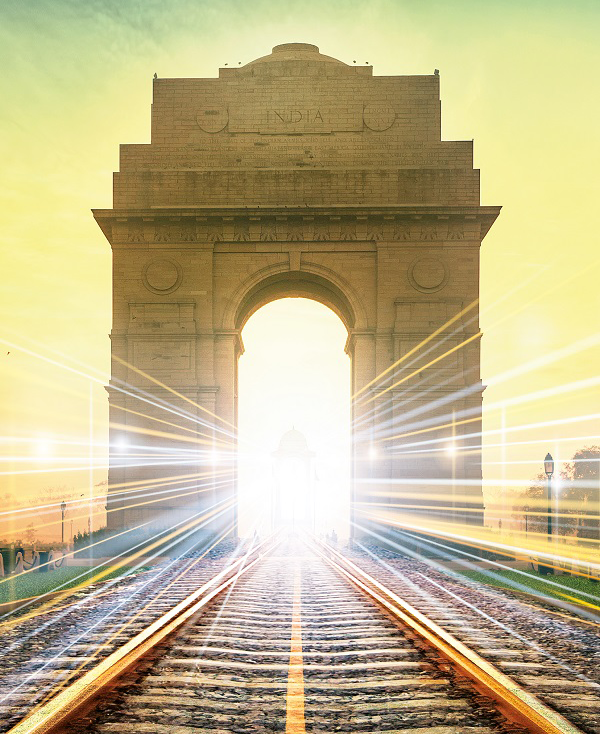Blog
The world watches India’s rail renaissance
Jules Omura
20 November 2019

Formerly one was obliged to travel in India by the old cumbrous method of going on foot or on horseback, in palanquins or unwieldy coaches; now fast steamboats ply on the Indus and the Ganges, and a great railway, with branch lines joining the main line at many points on its route, traverses the peninsula from Bombay to Calcutta in three days. (Around the World in Eighty Days, Jules Verne (1873))
Merely 23 years after George Stephenson’s steam locomotives started commercial operations between Manchester and Liverpool in 1830, Asia’s first rail operation began in 1853 between Bombay and Thane covering 34 km.
Some 165 years on, India’s rail transport has grown to a route length of 68,442km, the fourth biggest network in the world, and transports 8.3 billion passengers and 1.2 billion tonnes of
freight annually1.
India’s love and fascination for these vital arteries and capillaries of the economy has created a unique culture where access to affordable rail transport is protected as a fundamental right.
In this rapidly growing economy, and with a sharply rising population, maintaining existing infrastructure will not be sufficient to keep up with demand.
Infrastructure megaprojects
The country’s first high-speed rail line between Mumbai and Ahmedabad is now under construction, with eight other HSR corridors approved. Urban rail is also high on the government’s agenda: 11 cities have inaugurated metro systems in the last six years, with new metros under construction or being planned in 13 further cities.
The government’s vast Dedicated Freight Corridor project is well underway, with six corridors totalling 9,958km, aiming to shift cargo traffic from road to rail: ‘one DFC train will be able to take as many as 1,300 trucks off the road2.’
Rail electrification will also help India meet its UN climate change pledge. Between 2014 and March 2019, 13,700 km of the network was electrified so 52% of the network now runs on electricity. The government plans to electrify the rest of the broad-gauge network by 2022, meaning 28,000 km will be electrified in the next three years, which will reduce CO2 emissions by 3.4 million tonnes per annum3.
Make in India
New generations of trains are emerging too. Hailed as a game changer, Vande Bharat Express ‘Train 18’ entered into service in February 2019, and it now runs on two routes from
New Delhi. India’s first semi-high-speed intercity EMUs, which travel at a top operational speed of 160 km/h, were designed and built domestically by Indian Railways’ subsidiary
Integral Coach Factory (ICF), making it a flagship project under the government’s Make in India campaign.
It was reported in October 2019 that an international tender for 60 new 160km/h EMUs was about to be announced. The media report stated that the trains would be delivered by 2022 at an estimated cost of Rs 380 billion (USD 5.3 billion). Seven trains would be imported, with the remainder to be manufactured in India4.
In July 2019, plans to seek private investment to part fund the Rs 50 trillion ($700bn) required up to 2030 were announced. Part-privatisation of rail operations in India has also been widely discussed to inject much needed cash into the infrastructure.
Window to the world
The global railway sector is making a transition from a domestic-oriented, inward-looking culture to an international network of operations, a global supply chain, multimodal partnerships and cooperation with international peers who face similar challenges.
International Railway Summit advocates free exchange of people, goods and ideas. By hosting these meetings, we help rail operators learn about the latest trends and best practices, we introduce innovative solutions to those who are looking for them through online matchmaking and one-to-one meetings and we facilitate networking between peers and potential partners.
As India enters a new era of rail globalisation, international governments, rail operators and
manufacturers have shown much interest in forging partnerships. I hope that this summit will help deepen international ties between the participants.
The 8th International Railway Summit in New Delhi, India, is a unique networking event featuring a two-day conference programme delivered by sector leaders, bespoke one-to-one meetings, site visits, and a variety of formal and informal functions. The summit takes place from 20-22 November 2019.
Our thanks go to all speakers and sponsors contributing to the event. We are grateful for the kind support we have received from the Ministry of Railways of India in planning this summit and organising the technical visits to New Delhi railway station and the train control centre.
We are honoured to welcome the EU Transport Commissioner Violeta Bulc, and Chairman of the Railway Board, Ministry of Railways, India, Vinod Kumar Yadav, as keynote speakers at IRS8, amongst a particularly impressive line-up of Indian and international dignitaries.
Finally, we would like to thank our long-standing supporting partner, International Union of Railways (UIC) and their Director General François Davenne and Director of Rail System Christian Chavanel for valuable counsel and backing of our cause.
1 Indian Railways Year Book 2017-18.
2 Indian Railways Year Book 2017-18.
3 Ghanshyam Singh and Bhupender Singh Bodh, ‘Towards a greener future’, Railway Gazette, May 2019.
4 Srinand Jha, ‘Indian Railways to procure 60 new trains’, International Railway Journal, 7 October 2019.
Category: Blog freight International Railway Summit passenger rail
Tags: Dedicated Freight Corridor demand High-speed rail India infrastructure investment Make in India passenger rail population growth railway Research and Innovation
About the author

Jules Omura is the Founder and Managing Director of IRITS Events Ltd, the organisers of the International Railway Summit.